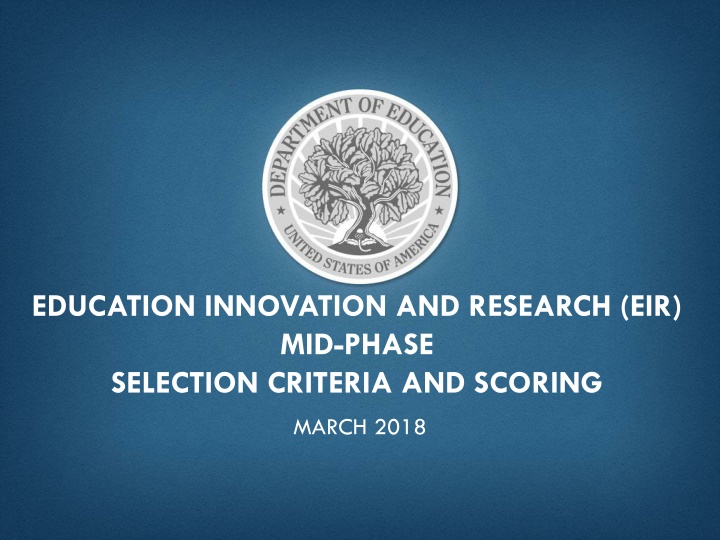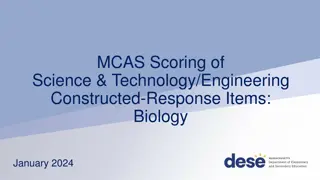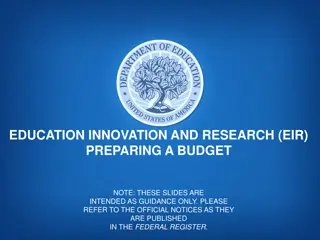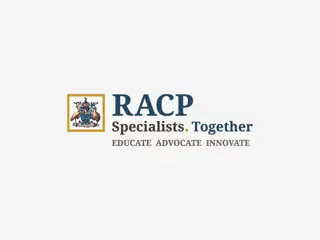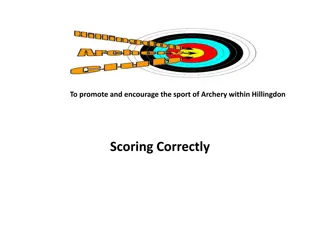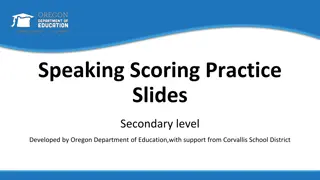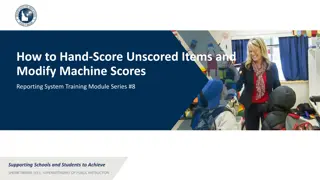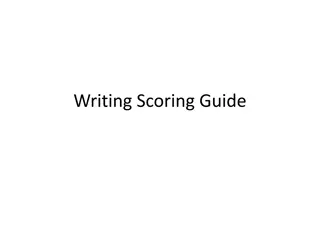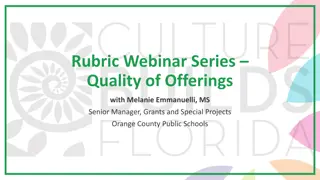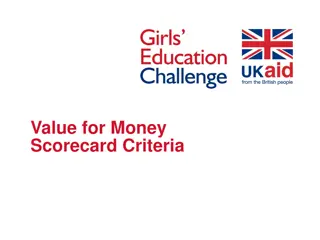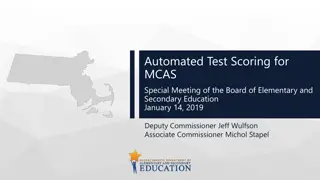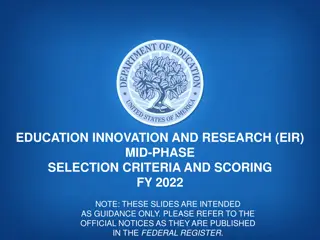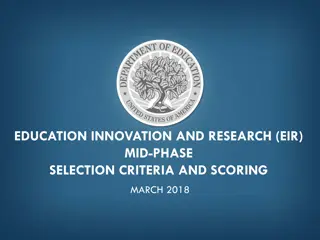EIR Mid-Phase Selection Criteria and Scoring
This document outlines the selection criteria and scoring process for the Education Innovation and Research (EIR) Mid-Phase program in March 2018. It covers the significance, scaling strategy, project design, and management plan aspects, providing valuable insights for applicants and evaluators. The content includes detailed descriptions of each criterion, points allocation, and examples to guide participants through the evaluation process effectively.
Download Presentation

Please find below an Image/Link to download the presentation.
The content on the website is provided AS IS for your information and personal use only. It may not be sold, licensed, or shared on other websites without obtaining consent from the author.If you encounter any issues during the download, it is possible that the publisher has removed the file from their server.
You are allowed to download the files provided on this website for personal or commercial use, subject to the condition that they are used lawfully. All files are the property of their respective owners.
The content on the website is provided AS IS for your information and personal use only. It may not be sold, licensed, or shared on other websites without obtaining consent from the author.
E N D
Presentation Transcript
EDUCATION INNOVATION AND RESEARCH (EIR) MID-PHASE SELECTION CRITERIA AND SCORING MARCH 2018
Mid-phase Selection Criteria Criterion Points A.Significance 15 B. Strategy to Scale 30 C. Quality of Project Design and Management Plan D. Quality of the Project Evaluation 35 20 2
A. SIGNIFICANCE (15 PTS) MID-PHASE 1) The magnitude or severity of the problem to be addressed by the proposed project. 2) The national significance of the proposed project. 3) The extent to which the proposed project represents an exceptional approach to the priority or priorities established for the competition. 3
B. STRATEGY TO SCALE (30 PTS) MID-PHASE 1) The extent to which the applicant demonstrates there is unmet demand for the process, product, strategy, or practice that will enable the applicant to reach the level of scale that is proposed in the application. 2) The extent to which the applicant identifies a specific strategy or strategies that address a particular barrier or barriers that prevented the applicant, in the past, from reaching the level of scale that is proposed in the application. 3) The feasibility of successful replication of the proposed project, if favorable results are obtained, in a variety of settings and with a variety of populations. 4
WHAT HAVE WE LEARNED ABOUT SCALING? See Investing in Innovation (i3) white paper at: https://i3community.ed.gov/insights- discoveries/2207 Topics Covered: Using multiple methods to establish buy-in; Building a regional and national infrastructure; Adapting practices based on evidence; and Planning for sustainability from day one. 5
C. QUALITY OF PROJECT DESIGN AND MANAGEMENT PLAN (35 PTS) MID-PHASE 1) The extent to which the goals, objectives, and outcomes to be achieved by the proposed project are clearly specified and measurable. 2) The adequacy of the management plan to achieve the objectives of the proposed project on time and within budget, including clearly defined responsibilities, timelines, and milestones for accomplishing project tasks. 3) The adequacy of procedures for ensuring feedback and continuous improvement in the operation of the proposed project. 4) The potential and planning for the incorporation of project purposes, activities, or benefits into the ongoing work of the applicant beyond the end of the grant. 6
MANAGEMENT PLAN ELEMENTS TO CONSIDER 1. Goal(s): A broad statement(s) of what the project intends to accomplish. What do you hope to accomplish by implementing your project? 2. Objective(s): A concrete attainment that can be achieved by following a number of steps. What is your project doing to support the overall program goal(s)? Are your objectives SMART (Specific, Measurable, Achievable, Relevant, and Time-bound)? 3. Performance Measures: A measurable or observable indicator to assess how well objectives are being met. How will you measure the success of your project? 4. Activities: Day to day pieces that must be completed to signal that the grant is on track. 5. Timeline (Start/End Dates): Provide some timeline that will allow task monitoring. 6. Responsible Personnel: Who will be carrying out those activities? 7
MANAGEMENT PLAN EXAMPLE Goals Objectives Measures Activities Start Date End Date Responsible Status Notes Personnel Goal 1: Increase involvement of Smith Elementary School families in their students education. Objective 1.1: Logins on the Smith Elementary School Online Parent Training System will increase 25% from baseline to the end of the grant. Performance Measure 1.1a: Parents reporting in an annual survey knowing about the Online Parent Training System. Activity 1.1.1: Administer parent survey to get baseline data. Activity 1.1.2: Create a pamphlet for parents that describes how to access and use the Parent Portal. Activity 1.1.3: Distribute pamphlet during school-wide events and parent-teacher conferences. Activity 1.1.4: Design a training for parents on using the Parent Portal Activity 1.1.5: Organize a focus group on the Parent Portal to gather parent feedback. 9/1/2016 9/15/2016 Evaluation Team Not Begun 3/1/2016 3/15/2016 Project Director Completed Performance Measure 1.1b: Number of logins per year. 9/15/2016 12/1/2016 Project Coordinator Not Begun 2/1/2016 3/1/2016 Project Director Completed 11/15/2016 12/1/2016 Evaluation Team Not Begun Activity 1.1.6: Deliver Parent Portal trainings. 9/15/2016 12/1/2016 Project Director & Project Coordinator In Progress Scheduled for 10/1 and 11/1. Activity 1.1.7: Administer parent survey. 5/1/2017 6/1/2017 Evaluation Team Not Begun Activity 1.1.8: Collect monthly reports on parent logins. 10/1/2016 12/1/2016 Data Director In Progress Objective 1.2: The percentage of students with parents regularly engaging with the school will increase by 5% every school year. Performance Measure 1.2a: Percentage of students that have at least 1 parent/guardian attend 1 parent-teacher conference per school year. Performance Measure 1.2b: Average parent attendance at school-wide events every school year. Activity 1.2.1 Activity 1.2.2 Activity 1.2.3 8
D. QUALITY OF PROJECT EVALUATION (20 PTS) MID-PHASE 1) The extent to which the methods of evaluation will, if well implemented, produce evidence about the project's effectiveness that would meet the What Works Clearinghouse standards without reservations as described in the What Works Clearinghouse Handbook (as defined in the notice). 2) The extent to which the evaluation will provide guidance about effective strategies suitable for replication or testing in other settings. 3) The extent to which the methods of evaluation will provide valid and reliable performance data on relevant outcomes. 4) The extent to which the evaluation plan clearly articulates the key project components, mediators, and outcomes, as well as a measurable threshold for acceptable implementation. 9
EVALUATION EXPECTATIONS MID-PHASE Must be an independent evaluation. Design must have potential to meet What Works Clearinghouse standards without reservations. Must examine cost-effectiveness of practices. Encouraged to include focus on the grant s scaling strategy. Encouraged to identify potential obstacles and success factors to scaling. 10
TECHNICAL ASSISTANCE RESOURCES ON EVALUATION 1. WWC Procedures and Standards Handbooks: https://ies.ed.gov/ncee/wwc/Handbooks 2. Technical Assistance Materials for Conducting Rigorous Impact Evaluations : http://ies.ed.gov/ncee/projects/evaluationTA.asp 3. IES/NCEE Technical Methods papers: http://ies.ed.gov/ncee/tech_methods/ 4. In addition, applicants may view one optional webinar recording that were hosted by the Institute of Education Sciences: a. Strategies for designing and executing experimental studies that meet What Works Clearinghouse evidence standards without reservations: http://ies.ed.gov/ncee/wwc/Multimedia.aspx?sid=18 11
WHAT IS A LOGIC MODEL? Logic model (also known as a theory of action) means a reasonable conceptual framework that identifies key components of the proposed project (i.e., the active ingredients that are hypothesized to be critical to achieving the relevant outcomes) and describes the theoretical and operational relationships among the key components and outcomes. 12
SAMPLE LOGIC MODEL Source: REL Pacific see link on next slide. 13
LOGIC MODEL RESOURCES Education Logic Model (ELM) Application (REL Pacific) http://relpacific.mcrel.org/resources/elm-app/ Logic models: A tool for effective program planning, collaboration, and monitoring (REL Pacific) https://ies.ed.gov/ncee/edlabs/regions/pacific/pdf/REL_2014025.pdf Logic models: A tool for designing and monitoring program evaluations (REL Pacific) https://ies.ed.gov/ncee/edlabs/regions/pacific/pdf/REL_2014007.pdf Logic models for program design, implementation, and evaluation: Workshop toolkit (REL Northeast and Islands) https://ies.ed.gov/ncee/edlabs/regions/northeast/pdf/REL_2015057.pdf 14
SUGGESTIONS FOR SELECTING AN EVALUATOR Is the evaluator closely familiar with What Works Clearinghouse standards? Has the evaluator conducted evaluations using a variety of designs and methodologies? Has the evaluator published? Does the evaluator have a team of qualified individuals? Is the evaluator independent? Does the evaluator have strategies for recruiting control sites and experience working with districts to gain appropriate consents and to share data? Does the evaluator have experience managing data records and protecting student privacy? 15
SUGGESTIONS FOR SELECTING AN EVALUATOR (2) Is your evaluator familiar with the literature in the area in which you re working? Do you see eye to eye on the goals of the evaluation, and would you have a good working relationship? Have you talked about what might happen to the design and/or the budget if things do not go as planned? Problems with recruitment Problems with attrition Delays or changes to the program Are your expected deliverables clearly defined? Have you clearly defined responsibilities of program staff vs. evaluators, or internal vs. independent evaluators? 16
OVERVIEW OF MID-PHASE REVIEW PROCESS Applications Sorted and Placed in Panels by Absolute Priority 2 (Field-Initiated) or Absolute Priority 3 (STEM) Each Application is Scored Against Selection Criteria Panel Review 3 Peer Reviewers Review and Score Selection Criteria A, B, and C (80 points possible) 2 Evaluation Reviewers Review and Score Selection Criterion D (20 points possible) All 5 reviewers meet to discuss the applications together Final Score = Average Score on Selection Criteria A, B, C + Average Score on Selection Criterion D (100 pts. Possible) There will be two separate rankings: one each for Absolute Priority 2 and 3 17
RECOMMENDATIONS FOR ORGANIZING YOUR APPLICATION We recommend that you organize and sequence your application narrative using the selection criteria. Within each criterion, make sure that you include a direct response to each of the factors under that selection criterion (we ll show you these in upcoming slides). Reviewers will be instructed that they may use material from anywhere in the application, including the appendices, to score and evaluate each criterion, but they will have an easier job if each section of your narrative is clear, well-organized, and complete and doesn t require them to search for information. When appropriate, use language from the selection criteria to help guide reviewers (For example, This project will be nationally significant because or This project represents an exceptional response to the Absolute Priority because 18
EDUCATION INNOVATION AND RESEARCH (EIR) MID-PHASE SELECTION CRITERIA AND SCORING MARCH 2018
